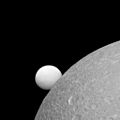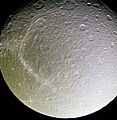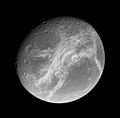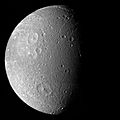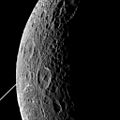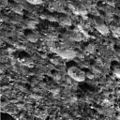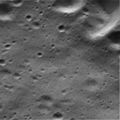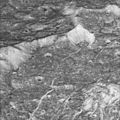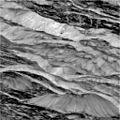
Dione in front of Saturn's rings.
Dione is the fourth largest moon of Saturn. It has a diameter of 1,123 km (698 miles). It was discovered in 1684 by Giovanni Domenico Cassini. It is named after the titan Dione in Greek mythology. The moon has many craters and ice cliffs. It is tidally locked with Saturn, meaning the same face of Dione always faces Saturn.
Images for kids
-
Animation of Helene's orbit relative to Saturn and Dione Polydeuces · Helene · Dione · Saturn
-
Size comparison of Earth, the Moon, and Dione.
-
Fractures bisecting older craters on Dione. Those running from upper right to lower left are the Carthage Fossae, whereas Pactolus Catena runs more horizontally at lower right.
-
-
Cassini enhanced-color composite of Dione, showing the darker, fractured terrain of the trailing hemisphere. The Padua Chasmata trace an arc on the left, interrupted near the top by a central peak crater.
-
Crescent Dione from Cassini, October 11, 2005. The crater near the limb at top is Alcander, with larger crater Prytanis adjacent to its left. At lower right, several of the Palatine Chasmata fractures are visible, one of which can be seen bisecting the smaller craters Euryalus (right) and Nisus.
-
Wispy terrain on Dione's trailing hemisphere. The Eurotas (top) and Palatine Chasmata run from upper right to lower left; the Padua Chasmata are near vertical at right, and the Carthage Fossae horizontal at left. The crater Cassandra and its ray system are at lower right.
-
Dione as seen by Voyager 1; the craters prominent at upper and lower left are Dido and Aeneas; to the latter's right are the troughs Latium and Larissa chasmata.
-
South polar features include huge, shallow impact basin Evander, the Palatine Chasmata by the terminator and Aufidus Catena between. The curving Padua Chasmata are at top.
-
Dione in front of the rings of Saturn
-
South polar impact basin Evander, 350 km in diameter, is by far the largest crater on Dione. The deep crater to its upper left is Sabinus.
-
Panorama with fractures (the Palatine Chasmata) near limb, bisecting craters Euryalus (right) and Nisus just left of center. Crater Silvius is at lower left, with Himella Fossa to its upper right.
-
Chasms on Dione (trailing hemisphere; north is up)
-
Close flyby of Dione reveals a highly cratered surface.
-
Nightside of Dione illuminated by Saturnshine.
-
-
Closer view of part preceding image
-
Differently sized and oriented fractures within 60-km crater Amastrus (central peak at lower right). Larger arcuate fractures running from lower left to upper right are the Padua Chasmata, whereas smaller more parallel fractures from lower right to upper left may be related to the Aurunca Chasmata.
-
Crop of preceding image. The bowl-shaped crater at upper right has bright streaks on its walls, and dark material on its floor. To its lower left can be seen an arcuate fracture postdated (covered) by a small crater's ejecta, which in turn is postdated (incised) by parallel fractures.
-
Oblique close-up of fractures
See also
 In Spanish: Dione (satélite) para niños
In Spanish: Dione (satélite) para niños
 In Spanish: Dione (satélite) para niños
In Spanish: Dione (satélite) para niños









